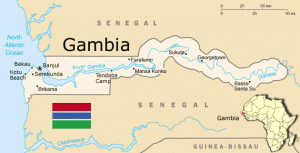Republic of The Gambia
The Gambia is a British colony and gained independence in 1965. The Gambia has 9 indigenous ethnic groups all speaking their own dialects and mixed with non-Gambians. The largest is the Mandinka (42%), followed by the Fula (19%), Wolof (16%), Jola (10%), Serers (2.5%), Serahule (8%), Bianunkas, Manjago’s and the creole (Aku) people. There are also other nationalities including Asians, Indians, Europeans and citizens of other African countries.
The beautiful meandering River Gambia divides the country through the length and breadth. Its surrounded on the three sides by Senegal and on one side by the north Atlantic Ocean. The Gambia is known as the Smiling Coast (Tropical Paradise) of Africa and its renowned with its hospitality treatment, stability, peace, tranquility, unique culture, fashion, creativity, friendly and welcoming nature of its citizens. This makes the country a tourism heaven in Africa. The country is also famous for its 80km coastline and it’s an all year-round destination for tourist. The Capital city of The Gambia is Banjul.
The Gambia is divided into five administrative Regions and one City. The divisions of the Gambia are Lower River Region, Central River Region, North Bank Region, Upper River Region, West Coast Region and Banjul. The Gambia is also additionally divided into eight Local Government Areas, of which two are the City of Banjul and the Municipality of Kanifing; these two collectively form Greater Banjul. The other six Local Government Areas (LGA) comprise of the five divisions. The Local Government Areas are further divided into 45 districts.
Yeriwah Mega Foundation provides affordable medical and surgical care to people who are unable to get medical care they need. These people live both in urban and rural areas within the five administrative divisions in The Gambia. They include adults, both men and women of all age groups and children. Yeriwah partners and works with the Health Ministry of The Gambia. Yeriwah also has collaboration with both Edward Francis Small Teaching Hospital and Serekunda General Hospital.
FACTS
Area: 11,295 sq. km (4,361 sq. miles)
Capital city: Banjul
Largest City: Serekunda
Population: 1.97 Million people
Major Languages: English (official), Mandinka, Wolof, Fula
Poverty Rate: 30 or 36.7% below the international poverty line of $1.25 USD per day
Infant mortality rate: 42.5/1000 Live births
Under Five mortality: 75.057/1000
Maternal mortality: 400/100,000
Unemployment rate: N/D
Life expectancy at birth: 58 years (men), 60 years (women)
Currency: Dalasi
Top 7 Causes of death all ages: Influenza & Pneumonia, Stroke, Coronary heart disease, Lung disease, Malaria and Diabetes mellitus.
